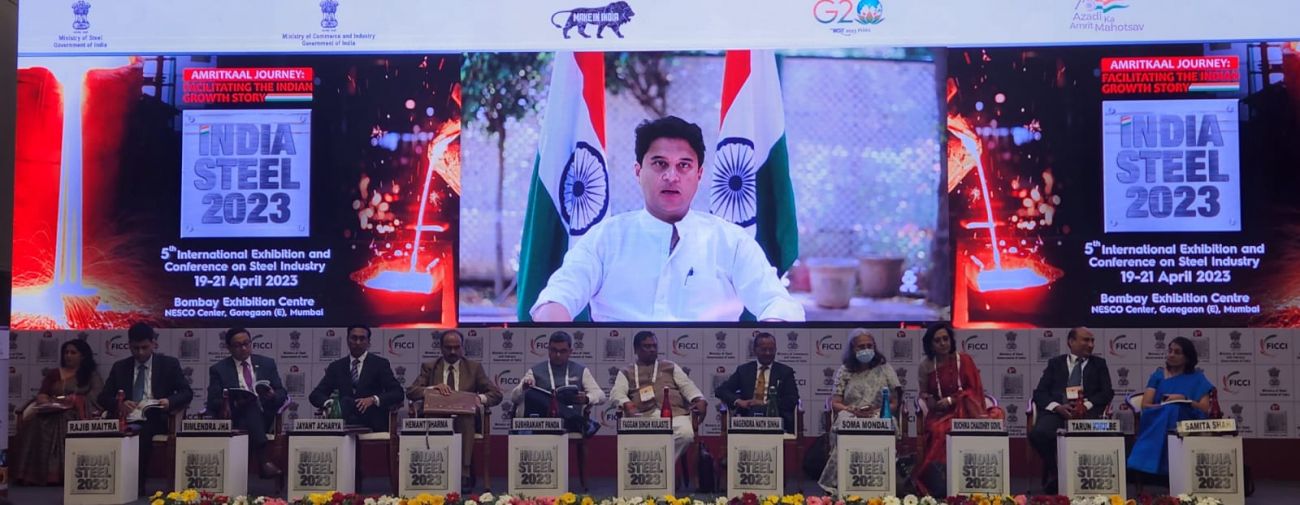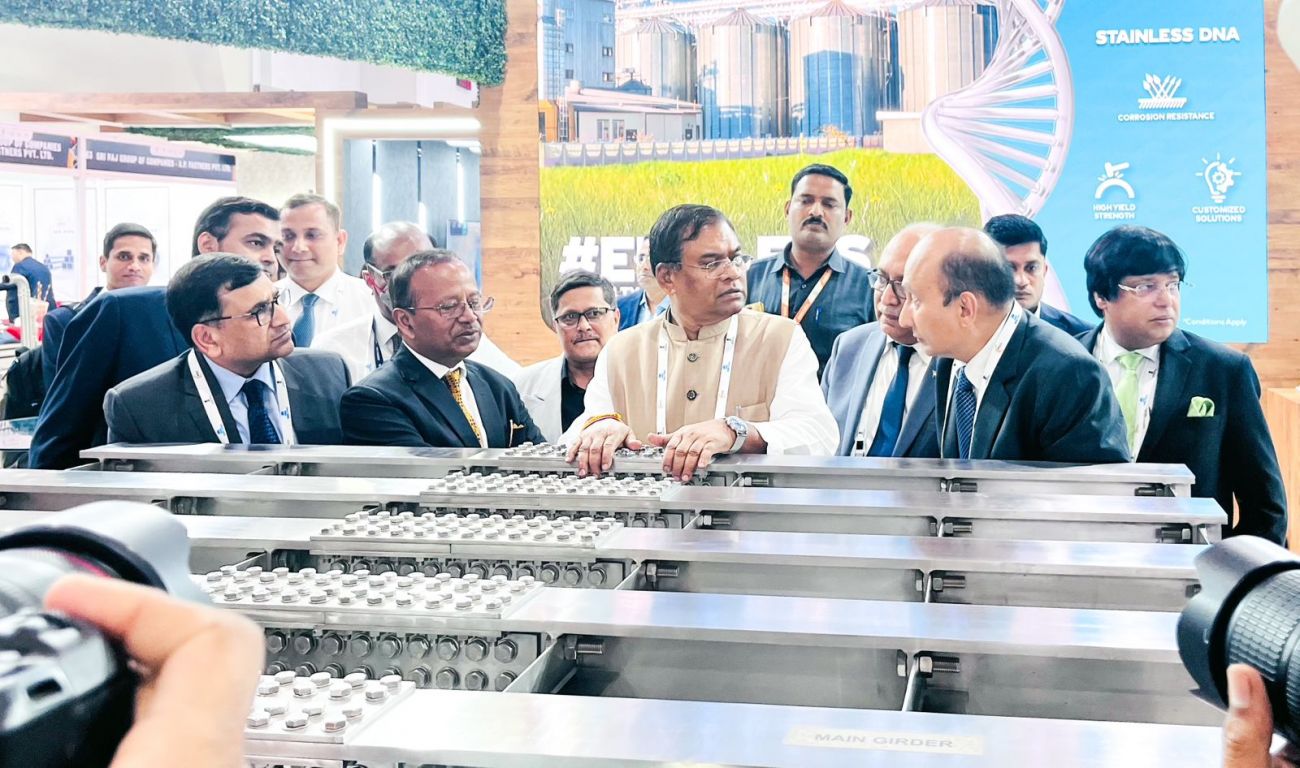60,000 Jobs to Be Generated as India Signs 57 MoUs with 27 Companies Under PLI Scheme for Specialty Steel

Mumbai, India – India’s steel industry is poised to lead global growth as the nation emerges as an epicenter for the sector’s evolution, according to Jyotiraditya M Scindia, Hon’ble Minister of Civil Aviation and Steel, Govt of India. Addressing the Ministry of Steel, Ministry of Commerce, Govt of India, and Federation of Indian Chambers of Commerce and Industry’s (FICCI) exhibition and conference, India Steel 2023, held from April 19-21 at Mumbai Exhibition Centre, the minister highlighted the country’s rapid ascent in steel production, with a growth of 6 percent CAGR over the last decade and a predicted 11-12 percent increase in consumption levels in the coming years.
“We have already emerged as the second largest steel producer in the world, and our per capita steel consumption has gone up from 57 kg to 78 kg during the last nine years. This proves our mandate to become a powerhouse of manufacturing and increase the share of Steel in GDP from 2 to 5 percent,” said Scindia. He pointed to four key factors contributing to the sector’s growth: collaborative efforts between the government and industry, the strengthening of national infrastructure, a focus on green steel production, and the adoption of new technologies.
|
Shri Faggan Singh Kulaste, Hon'ble Minister of State, Ministry of Steel and Rural Development |
Minister Scindia revealed that the Government recently signed 57 MoUs with 27 companies under the Production Linked Incentive (PLI) Scheme for specialty steel. This is expected to generate an investment of about INR 30,000 crore, create an additional capacity of 25 million tonnes of specialty steel within the next five years, and provide over 60,000 job opportunities. He also highlighted the Government’s commitment to producing green steel and reducing the sector’s carbon footprint. “We are taking appropriate steps to make the steel sector more green and sustainable,” he said, stressing the need for recycling and promoting the circular economy within the industry.
Finally, the minister underscored the importance of embracing technology and innovation to fast-track the steel sector. Scindia mentioned the formation of two Advisory Committees, one for Integrated Steel Producers and another for Secondary Steel Producers, to ensure the active participation of stakeholders in decision-making. “I strongly believe that as the next era of growth belongs to India, within India, the next era of growth belongs to the steel industry,” said Scindia, urging stakeholders to come together to drive the sector’s success and achieve the nation’s ambitious goals.
Tackling low-grade iron ore and consumption disparity
At FICCI India Steel 2023, Faggan Singh Kulaste, Minister of State for Rural Development and Steel of India in the Government of India, highlighted three critical topics for discussion during the conference, the first being the utilization of low-grade iron ore. He urged industry professionals to process and utilize low-grade iron ore within the country for steel production, saying, “It will result in creating employment opportunities, capital investment, and boosting the economy.”
Addressing the significant consumption gap between urban and rural areas, Kulaste pointed out that steel consumption in rural areas is only one-third of the national average. He emphasized the importance of bridging this gap by understanding rural needs, informing and training rural populations about steel products, and implementing similar programmes. Lastly, the Minister encouraged the secondary steel sector to adopt technology to enhance competitiveness and create more job opportunities.
Challenges facing the Indian steel industry
In his opening address, Subhrakant Panda, President, FICCI, emphasized the importance of the steel industry in facilitating India’s growth story. “Steel is the building block of new India and indeed a vital component in the nation’s economic development,” he stated. However, the Indian steel industry faces several challenges that need to be addressed to achieve its ambitious growth targets, such as decarbonization and the dependence on the import of coking coal.
He added that decarbonization is a crucial objective for the steel industry, with the government and private sector working together to develop a roadmap for the sector to transition to low carbon emissions. Furthermore, he noted, “Supportive policies and a conducive regulatory environment will enable the steel industry to overcome challenges and leverage the opportunities arising out of the significant growth trajectory that India is embarking upon.”
Steel consumption records humongous growth
Nagendra Nath Sinha, Secretary, Ministry of Steel, emphasized that the steel industry has experienced a growth rate of 12.7 percent in the past year alone, with steel consumption rising from 105 million tons in 2021-22 to 119 million tons in 2022-23. Further, while alluding to the domestic benefits of a thriving steel industry, he emphasised the potential for international cooperation. Sinha pointed out that India’s steel sector could play a crucial role in addressing other countries’ development and infrastructure needs while working towards a more integrated global economy.
Soma Mondal, Chair, FICCI Steel Committee and Chairman, Steel Authority of India; Hemant Sharma, Principal Secretary, Industries Department, Government of Odisha; and Ruchika Chaudhry Govil, Additional Secretary, Ministry of Steel, Government of India, among others, also spoke on occasion.
Image Source: Federation of Indian Chambers of Commerce and Industry (FICCI)




 Facebook
Facebook.png) Twitter
Twitter Linkedin
Linkedin Subscribe
Subscribe